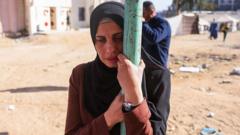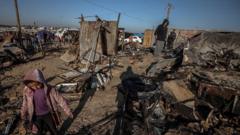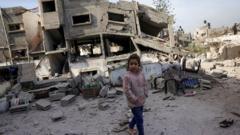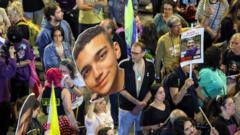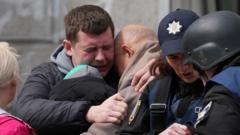A devastating airstrike in Gaza's Shejaiya neighborhood has left a tragic toll of human lives, sparking outrage and ongoing concerns about civilian safety in the region.
**Tragic Aftermath of Israeli Airstrike Claims Lives of 29 in Gaza**
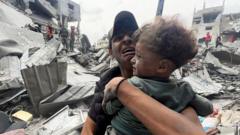
**Tragic Aftermath of Israeli Airstrike Claims Lives of 29 in Gaza**
At least 29 Palestinians, including children, lose their lives as Israeli military targets a residential building; condemnation grows amid rising tensions.
In a recent Israeli airstrike on a residential building in Gaza City, at least 29 individuals, including children, have reportedly lost their lives, according to local medical sources. The attack occurred on Tuesday morning near the al-Hawashi mosque in the densely populated Shejaiya neighborhood. The Hamas-affiliated Civil Defence agency initially reported 23 fatalities but later updated the figure as first responders began searching through the debris, revealing more victims.
The Israeli military clarified that the airstrike targeted a senior Hamas member believed to be responsible for orchestrating attacks in the area. They asserted that measures were taken to minimize civilian casualties, including employing precision-guided weapons. The military accused Hamas of endangering civilians by using them as human shields.
Witnesses describe the scene as chaotic, with video footage capturing distraught family members and rescue workers carrying dust-covered bodies from the rubble. Eyewitness Ayub Salim described the scene as "horrific" and noted that the area was crowded with displaced individuals and makeshift homes, raising questions about the targeted nature of the strike.
In response to the tragedy, Hamas condemned the airstrike as a "bloody massacre," as residents of Shejaiya stated that they were led to believe the area was a refuge amidst the ongoing conflict. Many families remained despite evacuation orders, believing they were in a designated safe zone.
In the lead-up to the strike, Gaza's Hamas-run health ministry reported at least 33 casualties due to Israeli attacks within the prior 24 hours, estimating a total of 1,482 deaths since the renewed air and ground operations commenced against Hamas earlier in March. Israeli officials stated they had targeted over 45 locations associated with Hamas, including weapon manufacturing sites.
The conflict's escalation has resulted in widespread displacement, with the UN highlighting that an estimated 390,000 people have been uprooted in recent weeks. Areas designated as "no-go" zones have expanded, further complicating humanitarian efforts.
UN Secretary General António Guterres has condemned the Israeli blockade on Gaza, stating it violates international law and contributes to civilian suffering. He warned of a humanitarian crisis, describing Gaza as a "killing field."
Israeli officials refuted claims of humanitarian aid shortages, asserting that significant aid had entered Gaza since the start of the conflict. However, human rights organizations argue the situation on the ground remains dire, with continued calls for civilian protection and a renewed ceasefire.
As mediators strive to restore peace, diverging narratives from both sides highlight the complexities and escalating tensions following the initiation of military operations responding to a recent cross-border attack that left numerous casualties and hostage situations in its wake.
The Israeli military clarified that the airstrike targeted a senior Hamas member believed to be responsible for orchestrating attacks in the area. They asserted that measures were taken to minimize civilian casualties, including employing precision-guided weapons. The military accused Hamas of endangering civilians by using them as human shields.
Witnesses describe the scene as chaotic, with video footage capturing distraught family members and rescue workers carrying dust-covered bodies from the rubble. Eyewitness Ayub Salim described the scene as "horrific" and noted that the area was crowded with displaced individuals and makeshift homes, raising questions about the targeted nature of the strike.
In response to the tragedy, Hamas condemned the airstrike as a "bloody massacre," as residents of Shejaiya stated that they were led to believe the area was a refuge amidst the ongoing conflict. Many families remained despite evacuation orders, believing they were in a designated safe zone.
In the lead-up to the strike, Gaza's Hamas-run health ministry reported at least 33 casualties due to Israeli attacks within the prior 24 hours, estimating a total of 1,482 deaths since the renewed air and ground operations commenced against Hamas earlier in March. Israeli officials stated they had targeted over 45 locations associated with Hamas, including weapon manufacturing sites.
The conflict's escalation has resulted in widespread displacement, with the UN highlighting that an estimated 390,000 people have been uprooted in recent weeks. Areas designated as "no-go" zones have expanded, further complicating humanitarian efforts.
UN Secretary General António Guterres has condemned the Israeli blockade on Gaza, stating it violates international law and contributes to civilian suffering. He warned of a humanitarian crisis, describing Gaza as a "killing field."
Israeli officials refuted claims of humanitarian aid shortages, asserting that significant aid had entered Gaza since the start of the conflict. However, human rights organizations argue the situation on the ground remains dire, with continued calls for civilian protection and a renewed ceasefire.
As mediators strive to restore peace, diverging narratives from both sides highlight the complexities and escalating tensions following the initiation of military operations responding to a recent cross-border attack that left numerous casualties and hostage situations in its wake.

